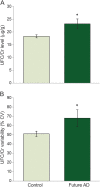Long-term cortisol measures predict Alzheimer disease risk
- PMID: 27986873
- PMCID: PMC5272965
- DOI: 10.1212/WNL.0000000000003537
Long-term cortisol measures predict Alzheimer disease risk
Abstract
Objective: To examine whether long-term measures of cortisol predict Alzheimer disease (AD) risk.
Method: We used a prospective longitudinal design to examine whether cortisol dysregulation was related to AD risk. Participants were from the Baltimore Longitudinal Study of Aging (BLSA) and submitted multiple 24-hour urine samples over an average interval of 10.56 years. Urinary free cortisol (UFC) and creatinine (Cr) were measured, and a UFC/Cr ratio was calculated to standardize UFC. To measure cortisol regulation, we used within-person UFC/Cr level (i.e., within-person mean), change in UFC/Cr over time (i.e., within-person slope), and UFC/Cr variability (i.e., within-person coefficient of variation). Cox regression was used to assess whether UFC/Cr measures predicted AD risk.
Results: UFC/Cr level and UFC/Cr variability, but not UFC/Cr slope, were significant predictors of AD risk an average of 2.9 years before AD onset. Elevated UFC/Cr level and elevated UFC/Cr variability were related to a 1.31- and 1.38-times increase in AD risk, respectively. In a sensitivity analysis, increased UFC/Cr level and increased UFC/Cr variability predicted increased AD risk an average of 6 years before AD onset.
Conclusions: Cortisol dysregulation as manifested by high UFC/Cr level and high UFC/Cr variability may modulate the downstream clinical expression of AD pathology or be a preclinical marker of AD.
© 2016 American Academy of Neurology.
Figures
Comment in
-
Letter re: Long-term cortisol measures predict Alzheimer disease risk.Neurology. 2017 Jul 4;89(1):106. doi: 10.1212/WNL.0000000000004074. Neurology. 2017. PMID: 28674159 No abstract available.
-
Author response: Long-term cortisol measures predict Alzheimer disease risk.Neurology. 2017 Jul 4;89(1):106. doi: 10.1212/WNL.0000000000004075. Neurology. 2017. PMID: 28674160 No abstract available.
References
-
- Armanini D, Vecchio F, Basso A, et al. . Alzheimer's disease: pathophysiological implications of measurement of plasma cortisol, plasma dehydroepiandrosterone sulfate, and lymphocytic corticosteroid receptors. Endocrine 2003;22:113–118. - PubMed
-
- Giubilei F, Patacchioli FR, Antonini G, et al. . Altered circadian cortisol secretion in Alzheimer's disease: clinical and neuroradiological aspects. J Neurosci Res 2001;66:262–265. - PubMed
-
- Näsman B, Olsson T, Fagerlund M, Eriksson S, Viitanen M, Carlström K. Blunted adrenocorticotropin and increased adrenal steroid response to human corticotropin-releasing hormone in Alzheimer's disease. Biol Psychiatry 1996;39:311–318. - PubMed
-
- Umegaki H, Ikari H, Nakahata H, et al. . Plasma cortisol levels in elderly female subjects with Alzheimer's disease: a cross-sectional and longitudinal study. Brain Res 2000;881:241–243. - PubMed
-
- Weiner M, Vobach S, Olsson K, Svetlik D, Risser RC. Cortisol secretion and Alzheimer's disease progression. Biol Psychiatry 1997;42:1030–1038. - PubMed
Publication types
MeSH terms
Substances
Grants and funding
LinkOut - more resources
Full Text Sources
Other Literature Sources
Medical

